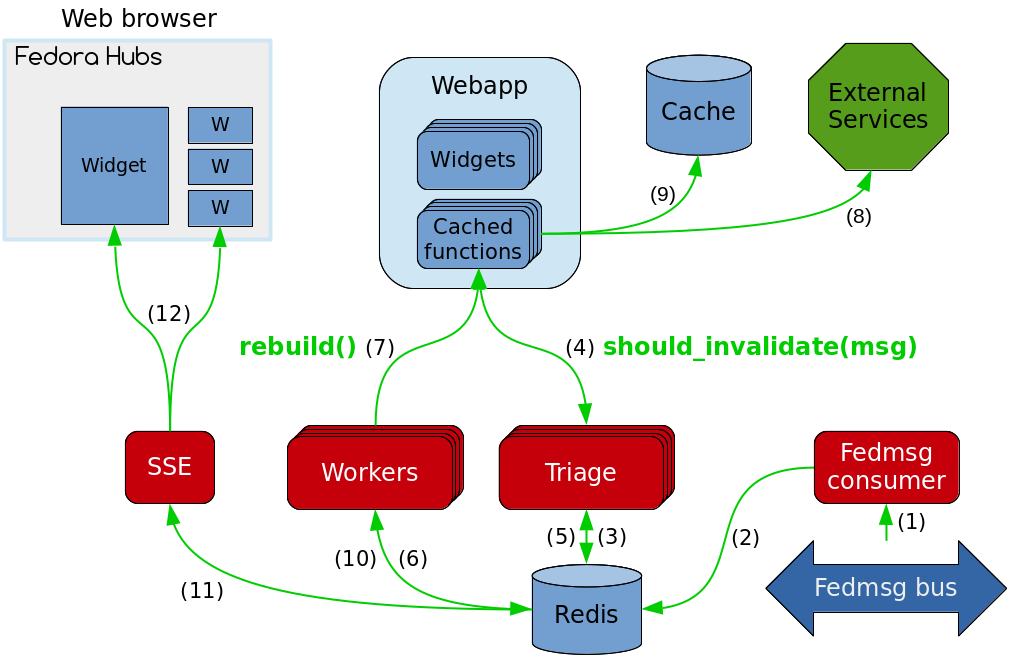7. Invalidate the cache¶
There are only two hard things in Computer Science: cache invalidation and naming things. – Phil Karlton
Now that the data is in the Hubs cache, it will stay there forever unless there is a configuration change or the cache is full and the data is evicted. Of course, this isn’t satisfactory since the status of package requests can change quickly. Not always as quickly as one would wish, but that’s another story.
7.1. How the cache invalidation works¶
Fedora Hubs uses Fedmsg to invalidate widget caches. Hubs declares a component
in hubs.backend.consumer that will subscribe to messages when
fedmsg-hub starts. This is what happens when a message is published on the
bus:
- The “Consumer” component stores the message in a Redis queue (steps 1 & 2 on the schema)
- One of the “Triage” daemons (
hubs.backend.triage) picks it up from the Redis queue (3), and passes this message to each cached function’sshould_invalidate()method (4). This method returnsTrueif the message should cause the cache to be invalidated,Falseotherwise. If it isTrue, the Triage worker will then add the reference of the cached function (and the widget it belongs to) to another Redis queue (5). - One of the “Worker” daemons (
hubs.backend.worker) picks it up from that Redis queue (6), and rebuilds the widget’s cache by running therebuild()method (7), which will call the cached function’sexecute()method (8) and store the results in the cache (9). Then, it will add a reference to the widget to yet another Redis queue (10). - The “SSE” daemon will read from that last Redis queue (11) and send an SSE message to the connected browsers that are currently displaying the widget (12). The Javascript in the page will reload the widget in-place, displaying the new information.

7.2. Adding automatic reloading¶
To benefit from Fedmsg-based cache invalidation and automatic reloading, a
widget author must only implement the should_invalidate() method of their
cached function(s).
Replace the current GetReviews.should_invalidate() method with the
following code:
def should_invalidate(self, message):
if ".bugzilla.bug." not in message["topic"]:
return False
try:
product = message['msg']['bug']['product']
component = message['msg']['bug']['component']
reporter = message['msg']['bug']['creator']
except KeyError:
return False
return (
product == "Fedora" and
component == "Package Review" and
reporter == self.instance.config["email"]
)
This implementation will first check if the message is about Bugzilla, then
test if it is a package review and if the reporter is the configured email
address. In that case the method will return True, otherwise it will return
False.
Note
The structure of the messages emitted by Bugzilla is available in this Fedmsg documentation.
You may have noticed that this implementation will cause the cache to be rebuilt more than necessary, for example if a comment is added to the ticket but the review state didn’t change. While it is true that this could be improved, remember that the “Worker” daemon will rebuild the cache in the background, and as a result the UI will never be slowed down by an empty cache. The worst that will happen here is useless XMLRPC queries to Bugzilla.
Now restart the Hubs framework with honcho start. This is the perfect time
to review a friends’ package request, just to test your work of course! :-p
Just remember to set your friend’s email in the widget configuration and watch
the bug change state in Hubs!
Next: 8. Wrap-up